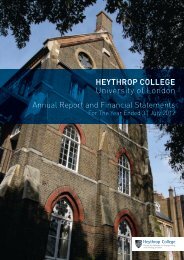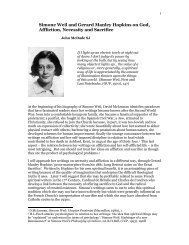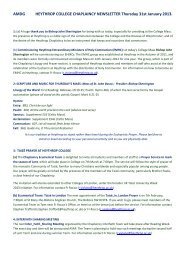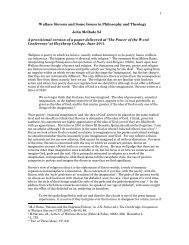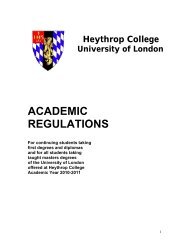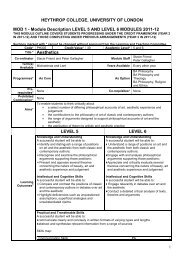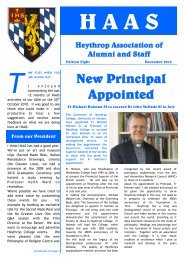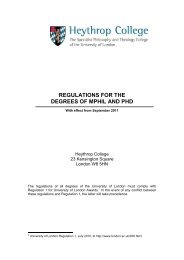Von Balthasar and the Office of Peter in the Church
Von Balthasar and the Office of Peter in the Church
Von Balthasar and the Office of Peter in the Church
Create successful ePaper yourself
Turn your PDF publications into a flip-book with our unique Google optimized e-Paper software.
2<br />
In <strong>Balthasar</strong>‟s view, <strong>the</strong> Papacy is misrepresented if it is pictured at <strong>the</strong> top <strong>of</strong><br />
an ecclesial pyramid: he regards this as a legacy <strong>of</strong> Imperial Rome <strong>and</strong> a<br />
reaction to <strong>the</strong> encroachments <strong>of</strong> medieval emperors. Such an image distorts<br />
<strong>the</strong> relation <strong>of</strong> <strong>the</strong> Papacy to <strong>the</strong> rest <strong>of</strong> <strong>the</strong> <strong>Church</strong> because <strong>the</strong> Pope is not<br />
„above‟ <strong>the</strong> <strong>Church</strong> <strong>in</strong> any serious sense, nor is <strong>the</strong> <strong>Church</strong> „under‟ him („..but it<br />
shall not be so with you.‟ (Lk 22.26). Only Jesus st<strong>and</strong>s above <strong>the</strong> <strong>Church</strong> as<br />
its Lord (308). Equally, <strong>Balthasar</strong> has little time for attempts to remove <strong>the</strong><br />
sc<strong>and</strong>alon <strong>of</strong> <strong>the</strong> Petr<strong>in</strong>e <strong>Office</strong> by s<strong>of</strong>ten<strong>in</strong>g it <strong>in</strong>to an Orthodox „honorary<br />
primacy‟ based upon <strong>the</strong> autonomy <strong>of</strong> particular churches (77). Instead, <strong>the</strong><br />
Papacy is one <strong>of</strong> <strong>the</strong> elements with<strong>in</strong> <strong>the</strong> complex identity <strong>of</strong> <strong>the</strong> <strong>Church</strong>: it is<br />
both a primary feature <strong>of</strong> <strong>the</strong> <strong>Church</strong> as „<strong>the</strong> guarantor <strong>of</strong> concrete unity <strong>in</strong><br />
<strong>the</strong> concrete centre <strong>of</strong> <strong>the</strong> <strong>Church</strong>‟ (127), <strong>and</strong> relative, „one <strong>of</strong> several<br />
<strong>in</strong>dispensable elements <strong>in</strong> <strong>the</strong> ecclesiastical structure‟ which, by <strong>the</strong>ir very<br />
relationship to one ano<strong>the</strong>r constitute <strong>the</strong> <strong>Church</strong>‟s identity (21). Hence both<br />
Protestantism <strong>and</strong> Papolatry are unacceptable, because <strong>the</strong>y dissolve <strong>the</strong><br />
differentiated character <strong>of</strong> <strong>the</strong> <strong>Church</strong>, one by excis<strong>in</strong>g episcopal <strong>and</strong> papal<br />
authority from <strong>the</strong> structure, <strong>the</strong> o<strong>the</strong>r by exalt<strong>in</strong>g <strong>the</strong> Pope above everyth<strong>in</strong>g<br />
else. He quotes Möhler‟s sharp comment on <strong>the</strong>ir common source <strong>in</strong> an<br />
exaggerated egoism:<br />
Protestantism is papism carried to <strong>the</strong> extreme, that is, complete<br />
egoism <strong>in</strong> pr<strong>in</strong>ciple. In papism each gives himself unconditionally to<br />
one person: <strong>in</strong> Protestantism, each one is <strong>in</strong> a position to oppose all<br />
o<strong>the</strong>rs (<strong>in</strong>s<strong>of</strong>ar as he makes <strong>of</strong> himself <strong>the</strong> pr<strong>in</strong>ciple <strong>of</strong> <strong>in</strong>terpretation <strong>of</strong><br />
revelation) (172).<br />
He prefers to speak <strong>of</strong> <strong>the</strong> „multi-dimensional reality‟ <strong>of</strong> <strong>the</strong> church‟ (26) <strong>the</strong><br />
„force-fields that bear upon <strong>the</strong> church‟ (22), <strong>the</strong> „network <strong>of</strong> tensions <strong>in</strong> <strong>the</strong><br />
<strong>Church</strong>‟(24). In <strong>the</strong> <strong>Church</strong>, <strong>the</strong>re are „more fundamental tensions‟ than that<br />
between primacy <strong>and</strong> collegiality or „monarchy‟ <strong>and</strong> „democracy‟ (sociological<br />
parallels from secular society are dismissed by him as <strong>in</strong>adequate to <strong>the</strong><br />
mysterium). In his view, <strong>the</strong> necessary tensions <strong>in</strong> <strong>the</strong> <strong>Church</strong> are nei<strong>the</strong>r <strong>the</strong><br />
symptoms <strong>of</strong> spiritual shortcom<strong>in</strong>gs nor flaws which can be remedied by<br />
structural change: <strong>the</strong>y are constitutive <strong>of</strong> <strong>the</strong> <strong>Church</strong> because <strong>the</strong> <strong>Church</strong> is<br />
<strong>in</strong>herently a complex, multi-dimensional network <strong>of</strong> pr<strong>in</strong>ciples which, <strong>in</strong><br />
<strong>the</strong>ir <strong>in</strong>teraction constitute <strong>the</strong> reality <strong>of</strong> <strong>the</strong> <strong>Church</strong> founded by Christ. (He<br />
rejects <strong>the</strong> idea that <strong>the</strong> orig<strong>in</strong>al form <strong>of</strong> <strong>the</strong> <strong>Church</strong> was a charismatic<br />
bro<strong>the</strong>rhood <strong>of</strong> equality, only later corrupted by patriarchal patterns <strong>of</strong><br />
government. Instead, <strong>the</strong> <strong>Church</strong> as shaped by Christ <strong>in</strong> its period <strong>of</strong> orig<strong>in</strong>s<br />
is differentiated <strong>and</strong> <strong>in</strong>vested with centres <strong>of</strong> authority, adjudication <strong>and</strong><br />
service.)<br />
He presents an account <strong>of</strong> <strong>the</strong> <strong>Church</strong> <strong>in</strong> which Mary, <strong>Peter</strong> <strong>and</strong> <strong>the</strong> o<strong>the</strong>r<br />
figures around Jesus form a network <strong>of</strong> pr<strong>in</strong>ciples which, <strong>in</strong> <strong>the</strong>ir mutuality,<br />
<strong>in</strong>teraction <strong>and</strong> tension, form <strong>the</strong> <strong>Church</strong> which relates to its Lord. <strong>Balthasar</strong><br />
approves <strong>of</strong> Congar‟s def<strong>in</strong>ition <strong>of</strong> Catholicity as „<strong>the</strong> dynamic universality <strong>of</strong><br />
<strong>the</strong> pr<strong>in</strong>ciples which yield her unity‟ (323); <strong>and</strong> proposes an ecclesiology <strong>of</strong><br />
symbolic archetypes as a way <strong>of</strong> identify<strong>in</strong>g <strong>the</strong>se constitutive pr<strong>in</strong>ciples <strong>and</strong><br />
missions which form <strong>the</strong> Catholica.



